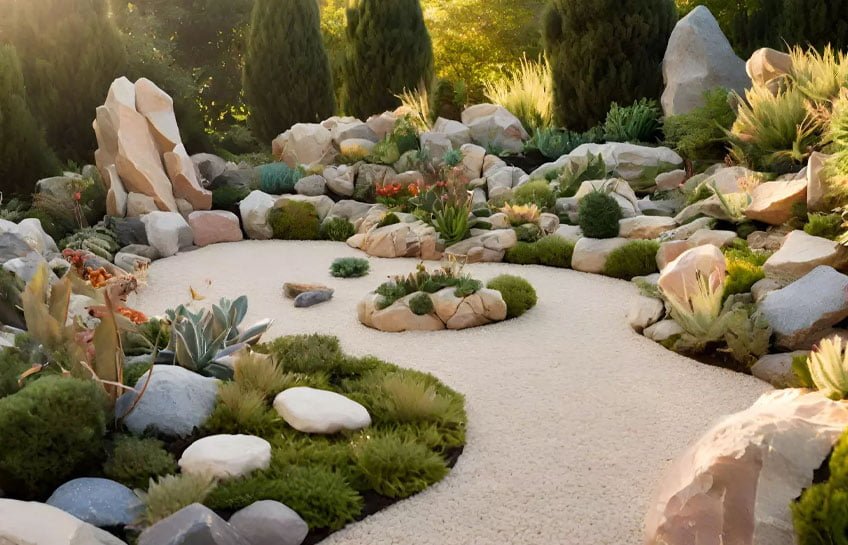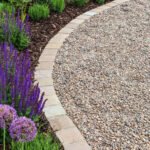Rock gardens have become increasingly popular landscape features due to their versatility, natural beauty, and environmentally friendly nature. Creative placement of aesthetically pleasing rocks, combined thoughtfully with plants, can transform even the smallest yard into an artistic haven. The only limit is your imagination – rock gardens allow ample opportunity for innovation. Read on as we explore the fundamentals of rock garden design and provide inspiration for bringing your unique vision to life.
The basics of rock garden design may appear simple at first – choose rocks and plants, group them artfully and voila! However, careful consideration of site location, terrain, soil needs, and overall cohesion will elevate your design from so-so to spectacular.
Starting Your Rock Garden: Preparation and Materials
After deciding on a location, assess your soil and drainage conditions. Amending soil may be necessary to achieve the fast-draining, lean-growing environment suited for alpine plants. Outline the garden beds and remove sod or weeds.
Rock choice makes a major impact aesthetically. Seek interesting shapes, varied colors, and different textural qualities. Some commonly used rock types and their best applications include:
| Rock Type | Features | Uses |
|---|---|---|
| Granite | Multi-colored, textured | Accents, edging |
| Limestone | Tan/gray, weathered | Paths, alpine beds |
| Lava rock | Dark, porous, lightweight | Soil amendment, drainage |
| River rock | Smooth, rounded, layered look | Water features, beds |
| Flint | Colorful, unique shapes | Focal points |
| Sandstone | Naturalistic, organic appearance | Dry creek beds |
Design 1: The Classic Zen Garden
Zen rock gardens’ origins lie in 9th century Japan, created by Buddhist monks as spaces for meditation. Hallmarks include simplicity, minimalism, tranquility and symbolic representation of natural concepts.
Modern interpretations incorporate raked sand or gravel with carefully placed rocks and boulders to evoke water, islands and mountains. Restrained plantings like mosses and grasses complement the serene vignette. Gentle lighting completes the oasis for relaxation and reflection.
Design 2: Alpine Rockery
For a rock garden with high visual impact, consider an alpine-esque design showcasing dwarf or miniature plants suited to fast-draining soil and excellent drainage.
Mimic a rugged mountain landscape in miniature with steep peaks, ridges, and valleys. Elevating beds, staggering heights, and orienting limestone or granite for optimal drama is key. Wind-sculpted conifers, spreading sedums, vivid alpine flowers and ornamental grasses thrive while highlighting the stone. Combine bonsai-like trees or dwarf evergreens for year-round interest in your elevated sanctuary.
Design 3: Succulent Showcase
Rock gardens naturally provide perfect drainage for drought-tolerant succulents to take center stage. Creative arrangements utilizing height, texture and form create visual interest. Contrast fine, delicate rosettes against bold vertical shapes or shiny leaves on trailing varieties.
Intermingle cobbles and boulders to form planting pockets or beds. Repeat shapes, colors, and groups of plants for harmony. Use restraint with additional decorative elements to maintain focus on the elegant rosettes and sculptural rocks. This low-maintenance combination thrives with minimal watering in well-drained gravel gardens.
Design 4: Dry Riverbed Garden
For organic inspiration, replicate the undulating form of desert washes or dry creek beds. Layering rounded river rocks in shades of gray, brown and tan evokes sand and silt. Dynamic narrow spaces between “boulders” allow for small but impactful plantings.
Carpet-forming sedums, Classics like salvia and yarrow plus ornamental grasses flow between meandering rocks. Incorporate regional natives, xeric perennials or succulents in the spectrum of foliage colors and textures. Accentuate changes in elevation for added interest. Let plants spill over edges, avoiding rigid lines. This flowing landscape celebrates water’s ephemeral legacy.
Design 5: Coastal Rock Garden
Capture the windswept essence of seaside landscapes with sculptural designs that withstand challenging conditions.
Incorporate weather-worn granite, sea glass accents and recycled bricks or oyster shells. Repeating rounded shapes and cool coastal hues reflect the natural environment. Choose plants like Erigeron, Sedum, and Verbena that thrive in lean, sandy conditions. Delicate grasses echo the movement of swaying reeds as they embrace stone outcroppings reminiscent of tide pools and inlets revealed briefly at low tide.
Design 6: Modern Minimalist Rock Garden
Less is more with contemporary clean-lined rock gardens in muted color schemes. Think serene monochromatic vignettes and understated plantings like succulents or ornamental grasses.
Subtle harmonies emerge from the thoughtful repetition of geometric boulders, organic weathered stones and selectively placed specimens.
Lead the eye through negative spaces between groupings inspired by wabi-sabi principles. Restraint and simplicity allow the inherent elegance of thoughtfully chosen elements to shine. Peace and calm permeate this modern re-envisioning of ancient rock garden concepts.
Design 7: Rock Garden Borders and Edging
Use rock gardens creatively to define and contain primary beds or walkways. Borders seamlessly blend with naturalized designs or provide crisp delineation in formal settings.
Rustic cobblestone, brick, or granite transitions to lawn. Low meandering dry-stack walls artfully divide garden rooms. Attractive edging showcases jewel-toned perennials or demure groundcovers to full effect without distracting from their subtle charm.
Let creativity guide you. Curve borders gently, angle in wide ribbons of stone or repeat modular blocks. Harmony emerges when materials suit the overall style. Well-designed rock borders beautifully showcase the finer details of the gardens they envelop.
Design 8: Rock Garden Water Features
Water transforms rock gardens into living works of art through soothing sounds, dynamic motion, and reflective qualities. Consider simple recirculating pumps within stone basins or wooden half-barrels.
Or create babbling brooks carrying water over inventoried collections of river rock. Formal ponds might incorporate granite boulders wrapped in delicate Japanese irises. For drama, fashion deep pools with towering waterfalls spilling from stone cliffs vibrant with delicate ferns or bold begonias.
Rock and water combinations provide infinite possibilities for you to emulate Mother Nature’s bounty through exceptionally designed sanctuaries.
Design 9: Cottage Rock Garden
Inviting cottage gardens focus on naturalistic design, diverse plantings and organic features like pathways of stone stepping stones or moss-covered rock borders.
Sun-dappled bird and butterfly havens dotted with whimsical artisanal accents complement the quintessential rambling style. Heirloom roses, Lilium, Digitalis and Clematis vines enliven gentle rockery beds. Weathered concrete urns allow vertical plants like star jasmine to shine. An eclectic umbrella creates dappled light across Hypertufa Trough’s alpine collection. Granite outcroppings house maidenhair ferns below weeping Japanese Maples. Each element adds to the charm and intimacy of the thoughtfully crafted whole.
Design 10: Shade Rock Garden
Shady sites need not limit rock garden options thanks to diverse collections of shade-loving plants perfectly suited to rocky humus-rich soil. Vibrant combinations of coral bells, astilbes, impatiens and ivies cascade softly over outcroppings.
Woodland natives like trillium, foamflower and violets carpet-shaded nooks. Spotlight architectural plants like Tiarella cordifolia against a stone. Emerald green mosses envelop boulders, host delicate ferns or serve as serene backdrops to Japanese forest grass varieties. Thoughtfully designed rock gardens can transform shady areas into verdant multi-faceted botanical jewels.
Design 11: Mediterranean Rock Garden
Conjure idyllic images of Tuscany, Provence or coastal Greece within intricately designed rock garden vignettes. Incorporate time-worn pottery, terra cotta tiles and accessories reminiscent of Southern Europe while selecting plants that thrive in hot, dry rocky crevices.
Silver-gray santolina, delicate tulbaghia and blooming rosemary pair elegantly with architectural agaves. The intricate leaves of Armeria maritime contrast beautifully with airy California poppies nodding below stone arches waiting to be discovered. If thyme, euphorbia and kniphofia thrive year-round, you have mastered the Mediterranean garden palette. Fill urns with lemon trees or cascading pink bougainvillea and let your imagination whisk you away!
Design 12: Rock Garden Sculptures and Art
Add personal expression and intimate detail with artful touches. Grace rock gardens with found-object wind chimes dangling from tree branches, brightly painted arbors framing cozy entryways or glass garden spheres refracting light. Introduce whimsical animal sculptures, abstract patterns or standing stones inscribed with the intention for peaceful connection.
Integrate functional sundials, rustic birdhouses and even living willow structures. Treasures imbued with symbolism, special memories or mythological meaning enhance the spiritual dimensions of thoughtfully created rock garden sanctuaries.
Maintenance Tips for Rock Gardens
Good planning facilitates easy care so your refuge thrives harmoniously with minimal effort. Group plants according to cultural preferences like sun exposure, water and soil needs. Use mulch to conserve moisture and restrict weeds. Establish pathways early to avoid soil compaction around delicate roots.
Provide extra grit and sharp drainage to alpines, amend planting pockets per specific plants or install irrigation systems to simplify upkeep. Trim wayward growth as needed. Weed by hand routinely to avoid chemical use. Remove fallen leaves/debris during winter months. With mindful yearly pruning and cleanup, your oasis will flourish beautifully!
The Transformational Power of Rock Gardens
Rock gardens offer almost endless options to add beauty and tranquility even on the smallest scale. They soothe the spirit, provide wildlife habitat and connect us to nature as seasons evolve. We hope these design examples and maintenance tips ignite further inspiration so your distinctive vision transforms into a cherished reality. Let the creative process unfold organically as you discover joy perfecting an innovative collaboration between elemental rocks and vibrant growing things across time.
Final Words
Rock gardens offer almost endless options to add beauty and tranquility even on the smallest scale. They soothe the spirit, provide wildlife habitat, and connect us to nature as the seasons evolve. We hope these design examples and maintenance tips ignite your inspiration so your distinctive vision transforms into a cherished reality. Let the creative process unfold organically as you discover joy in perfecting an innovative collaboration between elemental rocks and vibrant growing things across time.
Whether you prefer a simple Zen garden or an intricate alpine rockery, the creative possibilities are infinite. A thoughtfully designed rock garden becomes a sanctuary where one can retreat from the stresses of daily life. The meditative process of working with natural elements brings peace, while the finished landscape delights the eye. Seek inspiration from nature itself, then craft your own signature oasis. The only limit is your imagination!




No Comment! Be the first one.